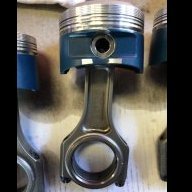Announcements
-
Similar Content
-
Latest Posts
-
Yuck. But it's kinda the same principle, moving timing around to make car run bad but sound good.... I went for a more spirited tuning drive to iron out a few things. Car no longer stalls, and it loved to dip RPM low when you clutch in. After tuning this (and the 4-5 tables that HPTuners/LS1 OEM ECU wants for idle air correction) it's now behaving somewhat normal. All expected because there's a new TB, new Intake manifold and that new TB which is 102mm vs 78... has an entirely different IAC passage which is smaller because ????? Unfortunately at this point I went to make further fine tuning changes to avoid it flaring up, you know... _tuning_ the HPTuners dongle died. Well to be more accurate - The USB cable died in a fashion that anyone who has ever charged a phone will recognize. After the app demanding I resync it 50 or so times (which all 'succeeded' but all failed) the device does not want to sync and I've logged a ticket with support to see if it's fixable. US Support said it was a 'storage issue' but after removing the SD card inside it and formatting it/fixing it the issue does persist. Unfortunately usually the fix is "Turn in your old dongle and pay $700 for the upgraded one" it's cheaper because I get some free licence credits I unfortunately don't need. However I'm 10 minutes down the road from HP Tuners AUS/VCM so at least I won't need to post it, and logged a new ticket for support over here. Definitely drives different. My SOTP dyno believes it's probably making 310-320kw instead of the 280 before. It scrambles for traction a little now whereas it previously different. It drives like a bigger cam car up top even though the cam is smaller, likely due to the cam not being advanced 6 degrees. The timing is deliberately low and the fuel is very rich so who knows if this will improve on the dyno. It may, imperceptably. Also funny is removing the pineapples definitely makes the car squat more and axle tramp less. So this behavior of having more top end, squatting more, and scrabbling for traction more makes me think = more power. But I could have just been sitting on the threshold of that kind of behavior before. Time will tell if my butt dyno is calibrated right. I need the exhaust leaks fixed before dyno tune for obvious AFR related reasons - I repositioned the pipes but I'm not confident it's fully sealed even if it is better. At least the car does drive around while I cannot tweak/tune it for now. And I have aircon again. medium success!
-
Don't use that manifold. Please don't use that manifold. Sunk cost fallacy is not worth the later pain. None of these will be relevant to the change that will come from the different turbo and manifold. As in, the effect of the exhaust will be nil, regardless of what else is changed. And all the cam and fuel system stuff is not changing either way, so has no effect. The turbo and manifold (and to a small extent the wastegate)....big change.
-
Just wanted to say thank you for your input my man (lead mechanic by trade) and I have done a heap of work as you can imagine just to make the hot side work with the dump pipe, stupid massive intake on turbo, trying to get the waste gate on was not fun. I’m kinda getting to the point where I don’t know if I try and make this work and not throw all this cash and time away or do I scrap the lot and start again? the Apexi I’ve got was tuned for a few slight differences: Tomei pon cams (mine are stock neo) Turbo smart 38mm external waste gate (mines 45mm replumbed) with stainless screamer pipe 3inch turbo back exhaust with high flow cat Sard 800cc top feed injectors Sard adjustable fuel pressure reg
-
By joshuaho96 · Posted
Out here E90s are the cheapest way into a sporty-ish car because everyone knows just how expensive the repairs can get. 8-10k USD for an automatic 335i.





Recommended Posts
Create an account or sign in to comment
You need to be a member in order to leave a comment
Create an account
Sign up for a new account in our community. It's easy!
Register a new accountSign in
Already have an account? Sign in here.
Sign In Now